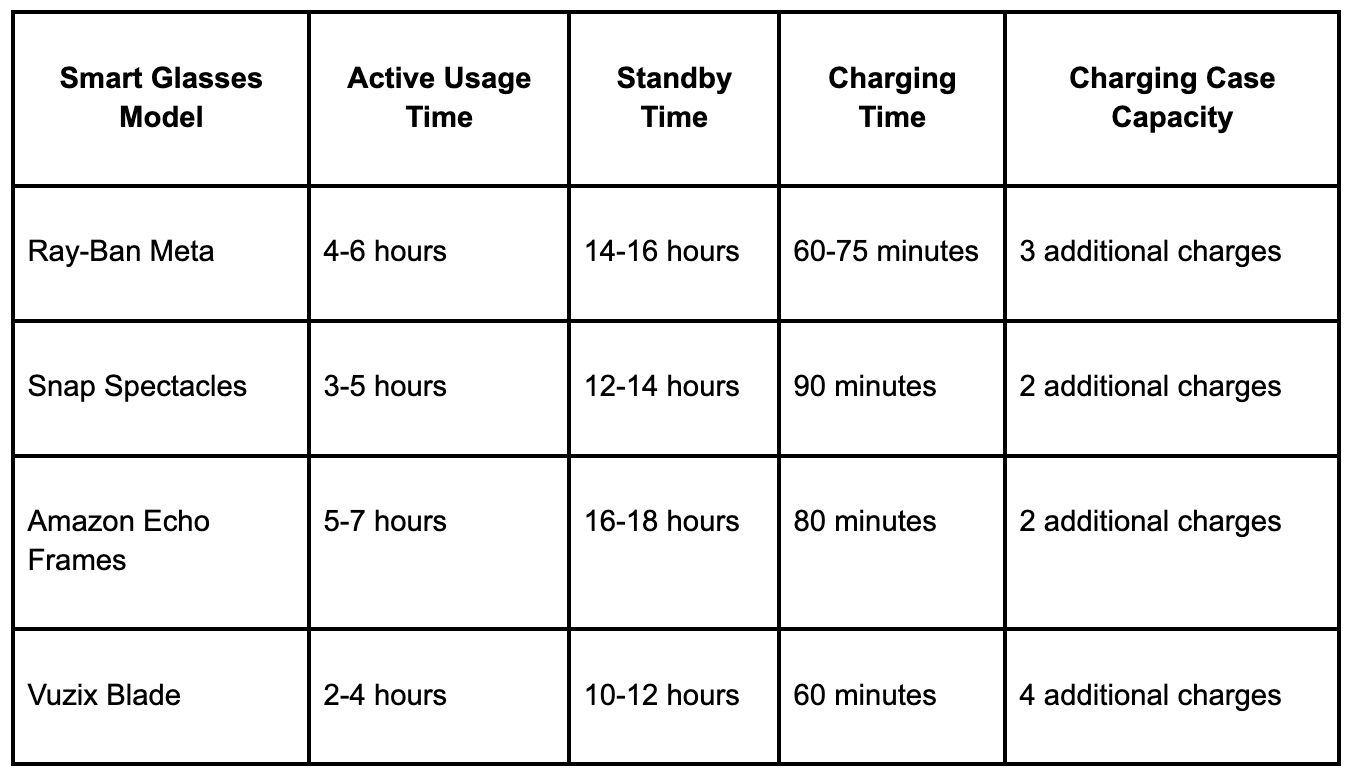How Long Do Ray-Ban Meta Smart Glasses Last? Battery Life Explained
This comprehensive guide explores everything you need to know about the battery life of Ray-Ban Meta Smart Glasses, helping you make an informed decision about whether these innovative eyewear options align with your lifestyle needs. For a complete setup and usage overview, start with our beginner's guide to Ray-Ban Meta smart glasses, then return here for advanced battery optimization strategies.
How Long Do Ray-Ban Meta Smart Glasses Last? Battery Life Explained
One of the most critical aspects that potential buyers consider before investing in any wearable device is battery performance. After all, what good is a smart device if it can't keep up with your daily activities? This comprehensive guide explores everything you need to know about the battery life of Ray-Ban Meta Smart Glasses, helping you make an informed decision about whether these innovative eyewear options align with your lifestyle needs.
Key Battery Life Specifications for Ray-Ban Meta Smart Glasses
Ray-Ban Meta Smart Glasses come equipped with a rechargeable lithium-ion battery that delivers variable performance depending on usage patterns. Here's what you can expect:
- Standard Usage Time: The glasses typically provide approximately 4-6 hours of active use on a full charge.
- Standby Time: When not actively using features, the standby time extends to approximately 14-16 hours.
- Charging Time: A complete recharge takes approximately 60-75 minutes using the included charging case.
- Charging Case Capacity: The charging case itself can provide up to 3 additional full charges for the glasses.
These specifications represent the baseline performance you can expect, though actual battery life will vary based on numerous factors that we'll explore in detail below.
Factors Affecting Battery Life in Ray-Ban Meta Smart Glasses
Understanding what impacts the battery longevity of your Ray-Ban Meta Smart Glasses can help you maximize their usage time between charges. Several key factors determine how quickly the battery depletes:
1. Feature Usage Intensity
The battery drain rate largely depends on which features you utilize most frequently:
- Photo and Video Capture: Taking photos or recording videos is among the most battery-intensive activities, consuming approximately 15-20% more power than standard operation. To maximize the impact of your captured content while managing battery efficiently, learn how to share directly to Instagram Stories and explore creative AR filter applications that add value without draining additional power.
- Voice Commands: Regular use of voice assistants will increase battery consumption by approximately 10-15%.
- Music Streaming: Continuous audio playback can reduce overall battery life by up to 30%. While entertainment is important, smart glasses technology is revolutionizing professional applications too. Marketing agencies are discovering how augmented reality in entertainment and media creates immersive brand experiences, often requiring extended battery performance for live events and demonstrations.
- Call Duration: Extended phone calls through the glasses can significantly impact battery performance, with each hour potentially reducing overall battery life by 20-25%.
2. Environmental Conditions
External factors play a substantial role in battery performance:
- Temperature Exposure: Operating in extremely cold (below 32°F/0°C) or hot (above 95°F/35°C) environments can reduce battery efficiency by up to 40%.
- Humidity Levels: High humidity environments may impact battery performance by 5-10%
3. Connectivity Factors
The way your glasses connect to other devices affects power consumption:
- Bluetooth Connection Stability: Unstable connections force the glasses to constantly search for signals, potentially increasing battery drain by 15-20%.
- Connected Device Proximity: Maintaining optimal distance between your phone and glasses (within 30 feet/10 meters) helps conserve battery life.
4. Software and Updates
The software running on your Ray-Ban Meta Smart Glasses directly impacts battery performance:
- Firmware Version: Newer updates often include battery optimization improvements.
- Background Processes: The number of processes running simultaneously affects power consumption.
- App Integration: Third-party applications may consume varying amounts of power depending on their optimization.
Real-World Battery Performance Scenarios
To provide a clearer picture of what to expect in everyday use, here are common usage scenarios and their approximate battery impacts:
Light User Profile (6+ Hours)
- Occasional photo taking (5-10 photos)
- Brief voice commands (10-15 times)
- Minimal call usage (under 20 minutes total)
- Notifications enabled but infrequent
Moderate User Profile (4-5 Hours)
- Regular photo capture (20-30 photos)
- Video recording (5-10 minutes total)
- Voice commands (30-40 times)
- Calls totaling approximately 30-45 minutes
- Regular notification interactions
Heavy User Profile (3-4 Hours)
- Extensive photography (50+ photos)
- Video recording (15+ minutes)
- Frequent voice assistant usage (50+ commands)
- Extended calls (60+ minutes)
- Continuous connection to streaming services
- Multiple app interactions
Maximizing Your Ray-Ban Meta Smart Glasses Battery Life
Implementing these practical strategies can help extend the battery life of your smart glasses:
Optimization Settings
- Adjust Brightness: Reducing display brightness can extend battery life by 10-15%.
- Manage Notifications: Limiting unnecessary notifications reduces wake-up cycles.
- Use Power Saving Mode: Engage power-saving features when battery levels fall below 30%
Usage Habits
- Strategic Recording: Plan video recordings rather than spontaneous extended captures.
- Temperature Awareness: Avoid using the glasses in extreme temperature conditions.
- Strategic Charging: Implement partial charging cycles to preserve long-term battery health (keeping the battery between 20% and 80%)
Maintenance Practices
- Regular Updates: Keep firmware current to benefit from battery optimization improvements.
- Proper Storage: Store glasses in their case when not in use to prevent unnecessary battery drain.
- Clean Connections: Ensure charging contacts remain clean for efficient charging.
Battery Lifespan and Longevity
Beyond daily battery life, potential buyers often wonder about the overall lifespan of Ray-Ban Meta Smart Glasses. The lithium-ion battery in these glasses typically maintains optimal performance for approximately 2-3 years with regular use, after which you may notice gradual capacity reduction.
Factors influencing long-term battery health include:
- Charging Habits: Frequent full discharges (letting battery reach 0%) accelerate capacity degradation.
- Usage Patterns: Daily heavy usage versus occasional use affects overall battery longevity.
- Storage Conditions: Proper storage when not in use helps preserve battery capacity.
Charging Options and Accessories
Ray-Ban Meta Smart Glasses come with several charging options designed to accommodate different lifestyles:
- Standard Charging Case: The included case provides both protection and charging capabilities.
- Fast Charging: A 15-minute charge can provide approximately 1-1.5 hours of standard usage.
- Compatible Power Banks: For on-the-go power needs, the glasses can be charged using portable power banks through the case.

Smart Glasses Battery Life Comparison Chart
When evaluating Ray-Ban Meta Smart Glasses against competing products in the smart eyewear market, battery performance represents a critical comparison point:

As the smart glasses market evolves, battery performance becomes a key differentiator for business adoption. Companies evaluating AR solutions should consider not just consumer battery life, but also enterprise requirements. Our business case for augmented reality advertising examines how battery performance impacts ROI in professional implementations, while our ultimate guide to AR advertisingprovides implementation frameworks that account for power management in campaign planning.
User Experiences and Feedback
Consumer feedback regarding Ray-Ban Meta Smart Glasses battery performance generally indicates satisfaction with everyday use. Most users report achieving the advertised battery life when following recommended usage guidelines, though heavy users occasionally express desire for extended battery capacity in future models.
Common user feedback includes:
- Appreciation for the quick-charge feature when in a hurry
- Satisfaction with the charging case's portable power solution
- Occasional frustration during all-day events without charging access
- General consensus that battery life meets expectations for the device category
Future Battery Technology Expectations
Industry analysts anticipate several advancements in battery technology that may benefit future iterations of Ray-Ban Meta Smart Glasses:
- Higher Density Batteries: Emerging battery technologies promise 20-30% increased capacity within the same physical footprint.
- Advanced Power Management: Improved software algorithms may extend battery life by optimizing power usage based on user patterns.
- Alternative Charging Methods: Solar-assisted charging or kinetic energy collection may supplement traditional charging in future models.
Conclusion: Is the Battery Life Sufficient for Your Needs?
Ray-Ban Meta Smart Glasses offer battery performance that aligns with industry standards for compact wearable devices. For most users engaging in typical daily activities, the 4-6 hour active usage time combined with the charging case's additional capacity provides sufficient power throughout the day.
When deciding if these smart glasses meet your battery life requirements, consider your usage patterns, access to charging opportunities throughout your day, and expectations for wearable technology. For those who prioritize extended uninterrupted use, carrying the charging case becomes an essential part of the Ray-Ban Meta experience.
Ultimately, these innovative glasses balance technological capability with reasonable battery performance, making them a compelling option for those seeking to embrace the future of wearable eyewear without sacrificing style or functionality. For businesses considering AR implementation, battery performance directly impacts campaign success and user experience.
Ready to explore how AR can transform your marketing strategy?
View our comprehensive case studies
to see real-world implementations, or
contact us
to create AR experiences optimized for smart glasses and other platforms.
TALK TO A PRO
We're here to bring your brand to life!
Stay Connected with BrandXR
Create Augmented Reality for Free!
Create, Publish, and Measure 3D Augmented Reality Experiences Without Having to Code.














